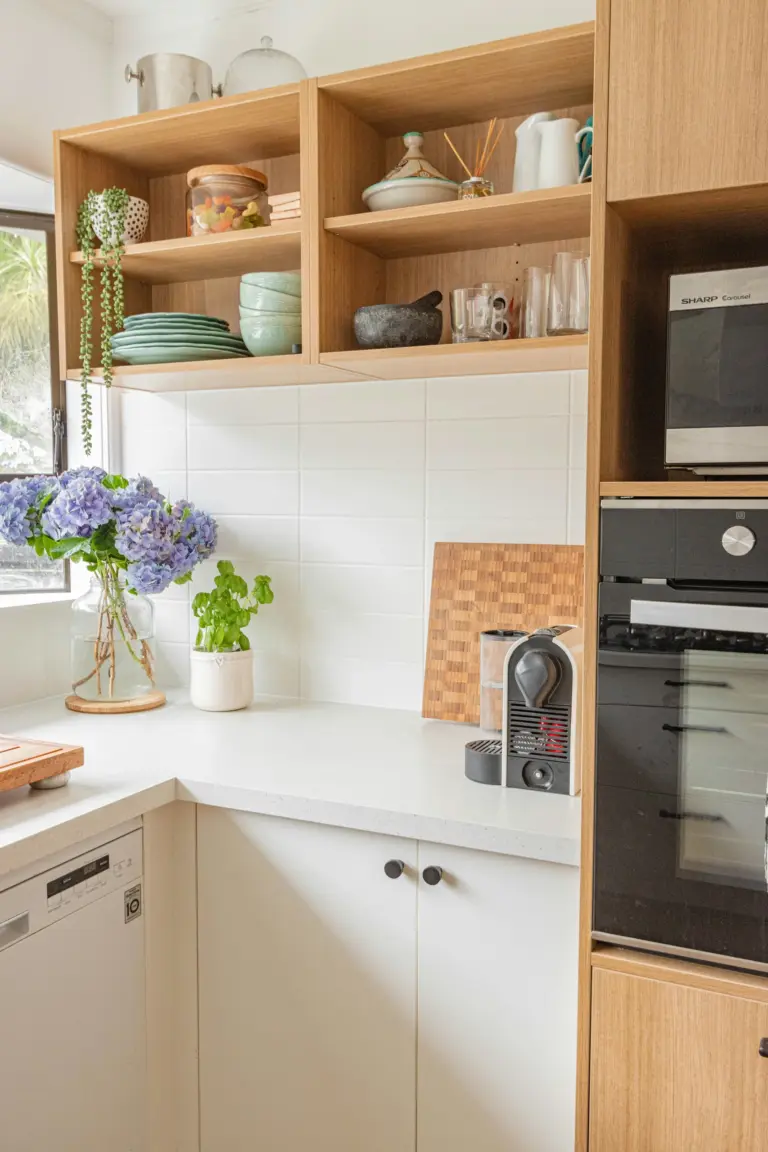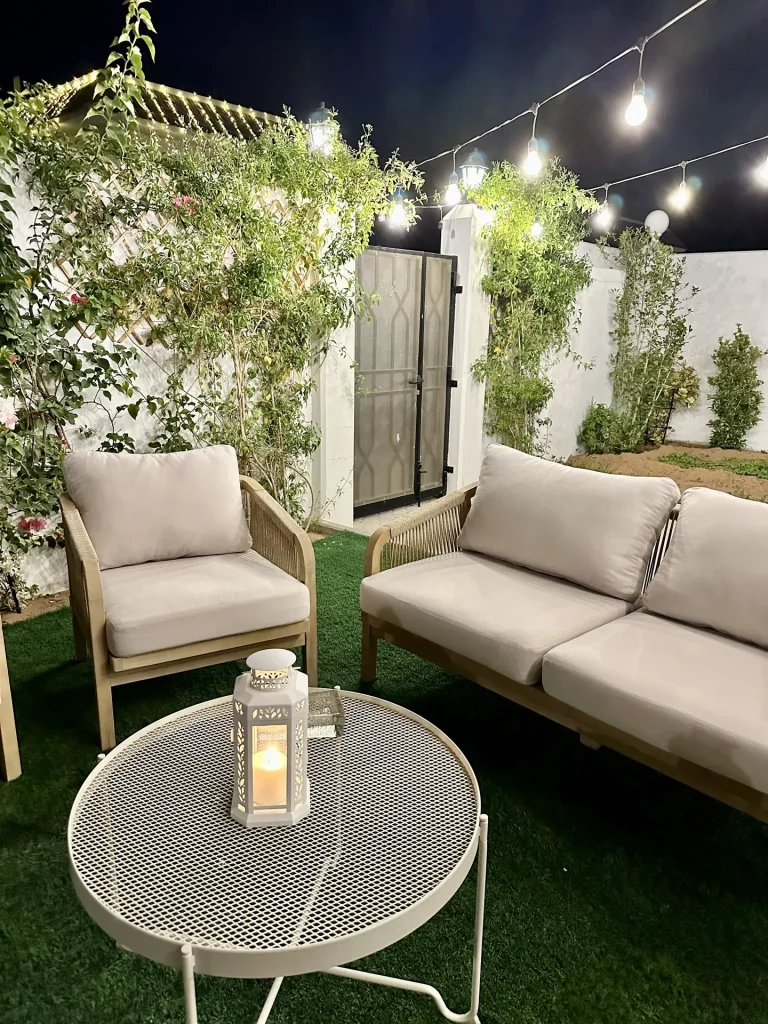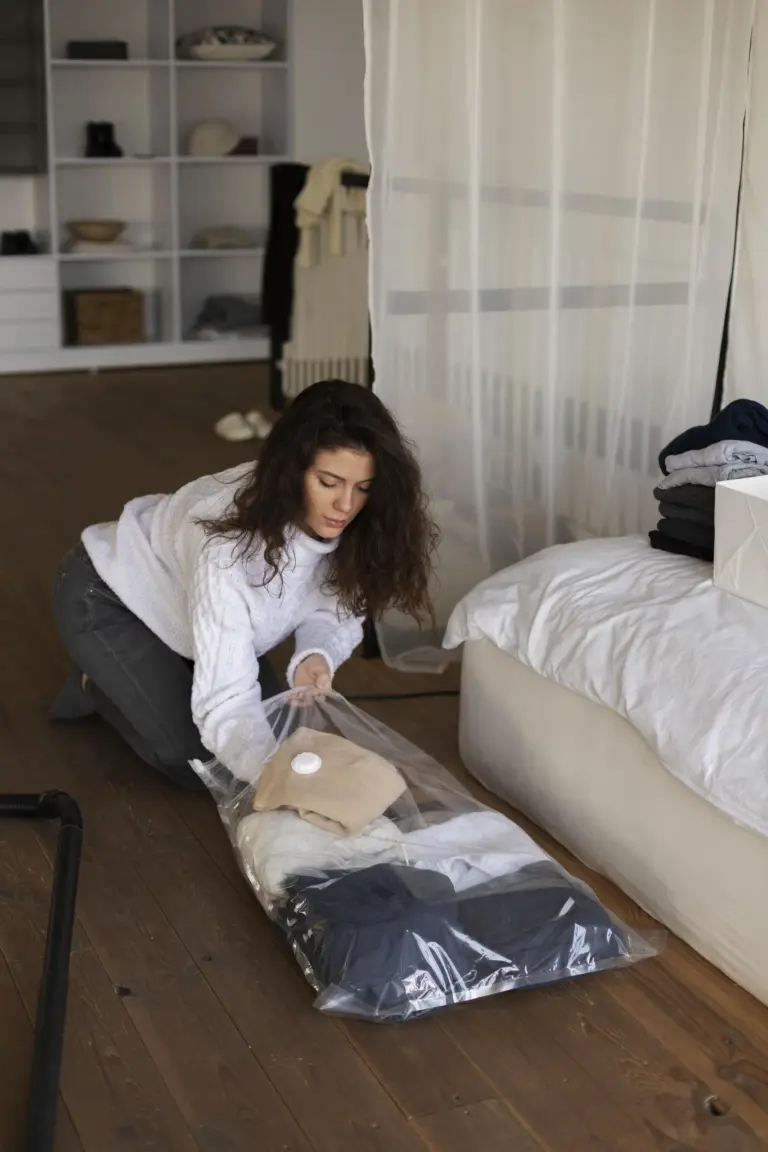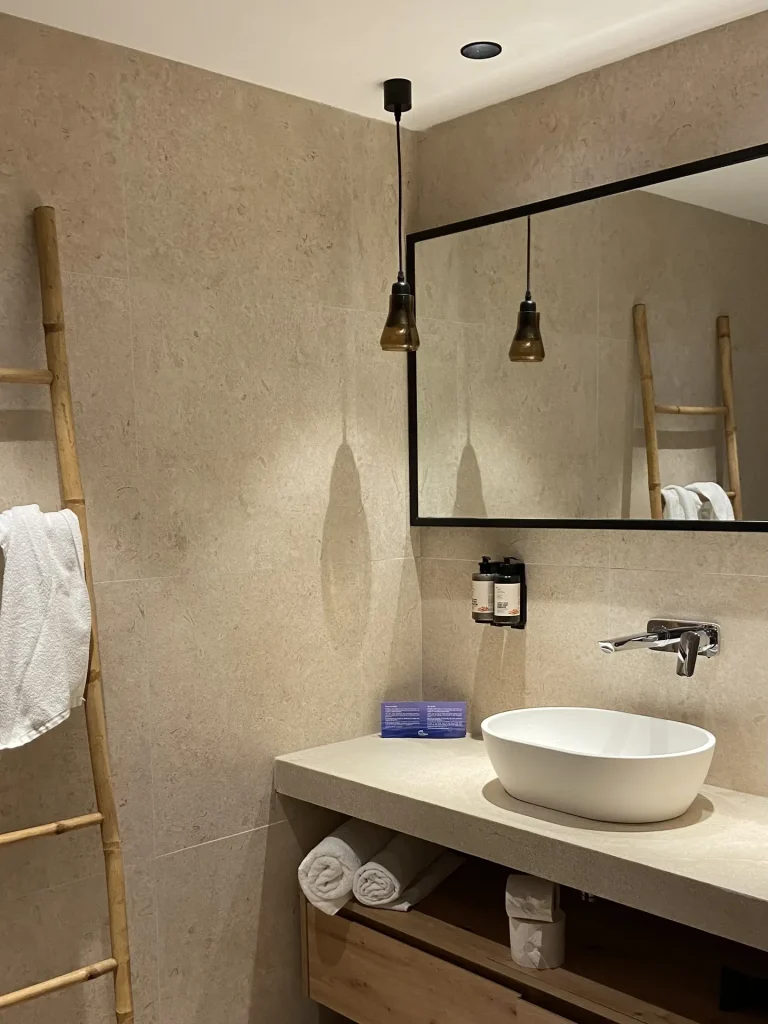The Complete Kitchen Lighting Guide: Transform Your Space With Bright Ideas You Never Knew Existed (+22 Kitchen Lighting Ideas)
This blog post is all about kitchen lighting ideas.

Ever tried chopping vegetables in a shadowy corner or setting the table under a light that feels more like a spotlight interrogation than a warm welcome?
The truth is, the way your kitchen is lit shapes not only how it looks but how it feels and functions every single day.
In this complete guide, I’ll break down the basics of good lighting in simple terms, walk you through step-by-step planning, and show you how to layer light so every task has its perfect glow. You’ll learn easy rules of thumb, explore different lighting types with their specifications and see how layouts change depending on your kitchen style.
And of course, I’ll share 22 inspiring kitchen lighting ideas that prove the right setup can completely transform your space, plus common mistakes to avoid and quick fixes that make all the difference.
By the end, you’ll see your kitchen in a whole new light, I promise!
This site includes affiliate links, meaning I may receive a small commission, at no additional cost to you.
Light-Basics: Short & Easy Explained
First things first: Good lighting doesn’t have to be complicated!
Once you know the basics, it’s easy to create the right atmosphere and functionality in your kitchen.
This short and simple breakdown is something you can trust:
Kelvin (color temperature):
For a warm, cozy feel in a kitchen-living space, stick to 2700-3000K. If you want it to feel a bit fresher but still inviting, go for 3000-3500K and keep it consistent throughout the room.
CRI (color rendering index):
Aim for CRI ≥ 90, with R9 > 50, so food and skin tones appear natural and vibrant.
Lux & Lumen (brightness):
Plan for 200-300 Lux as general ambient light, 500-800 Lux on work surfaces and 100-200 Lux for accents.
Your Perfect Kitchen Light: Step-By-Step Planning
Planning kitchen lighting step by step makes the process clear and well structured.
In my opinion, this method keeps you from overlooking details and helps you design a setup that looks thoughtful and exactly they way you want it.
You can follow this simple roadmap:
- Map the room: Measure dimensions, note the work triangle and keep in mind that dark finishes absorb more light.
- Define zones: Cooking/stove, prep areas, sink, island or dining bar, cabinet interiors and walkways.
- Set layers: Ambient, task and accent lighting, ideally on separate circuits and dimmable where possible.
- Choose Kelvin/CRI: Stick to one consistent color temperature family across all fixtures.
- Distribute lumens: Prioritize task lighting first, then fill in with ambient and finish with accent.
- Plan switches/scenes: Think in modes like Cook, Clean, Dine or Night for intuitive control.
Layered Lighting: Which Light Goes Where?
Layered lighting is the key to making a kitchen not only practical but also atmospheric and if you ask me, knowing which type of light goes where makes planning so much easier.
Split your lighting into ambient, task and accent. This gives you a flexible setup that works no matter what time it is.
Ambient (general lighting):
Flush-mount fixtures, recessed lights, linear ceiling profiles or indirect lighting along the crown. Gets you even brightness without harsh shadows.
Task (work lighting):
LED strips under upper cabinets, pendant lights with wide beams over islands or bars, range hood with built-in light over the stove. Lights up where you’re actually working.
Accent (mood/architectural lighting):
Light above cabinets, along the toe-kick at the base, inside glass cabinets or display spots, small spotlights on shelves. Adds depth and atmosphere instead of just flat brightness.
Numbers & Rules Of Thumb
Quick numbers and rules make planning kitchen lighting way less annoying. Don’t overcomplicate it.
Here’s what actually matters:
Recessed lights: Space them about half your ceiling height apart. 2.6m ceiling? Put them roughly 1.3m apart. Keep them 40-60cm from the wall above counters or you’ll be working in your own shadow. 40-60° beam angle for general lighting, narrower for accents.
Pendants over island: Hang them so the bottom sits 75-90cm above the counter. Leave at least one light’s width between each one.
Under-cabinet LED strips: Mount them 5-10cm back from the front edge or they’ll cast shadows. Get 700-1000 lumens per meter, CRI 90 minimum. Strips with 120+ LEDs per meter in an aluminum channel with a diffuser, otherwise you see dots which looks cheap.
Lighting Types & Specifications
Knowing the main types of kitchen lighting fixtures and their specs helps you pick the right stuff fast.
LED profiles work for under-cabinet, over-cabinet or cove lighting.
Get aluminum channels with diffusers and replaceable drivers so they last.
Downlights should be low-profile, IC-rated if you need it and check the glare rating (UGR) so they’re not annoying to look at.
Pendants or linear fixtures: Get ones with wide, even beams and opal diffusers. Makes the light soft instead of harsh.
For cabinets or glass displays, mini-spots or slim profiles add subtle highlights. Door sensors make them especially practical.
Drivers and dimming matter too. Whether it’s TRIAC/ELV, 0-10V, DALI or smart dimmers, make sure everything is compatible or you’ll get flickering, especially when dimmed low (1-10%).
Layout By Kitchen Type
The ideal lighting layout depends a lot on your kitchen shape and I think, tailoring the plan to the layout only makes sense.
Galley kitchen? Under-cabinet lights running continuous, plus downlights spaced out. That’s it.
L-shaped needs downlights on both walls, under-cabinet strips on each side, little accent light in the corner so it’s not dead dark.
U-shaped has more going on. Make each section dimmable on its own so you can adjust.
Island or peninsula? Hang pendants or a linear fixture above it and under-cabinet lights on the wall. Toe-kick lights at the bottom make a nice subtle nightlight.
Kitchen Lighting Ideas
Kitchen lighting does so much more than brighten a room, it also shapes the mood, highlights design details and makes everyday tasks easier.
To inspire your own setup, here are 22 kitchen lighting ideas that balance style and practicability beautifully.
1. Under Cabinet Lights
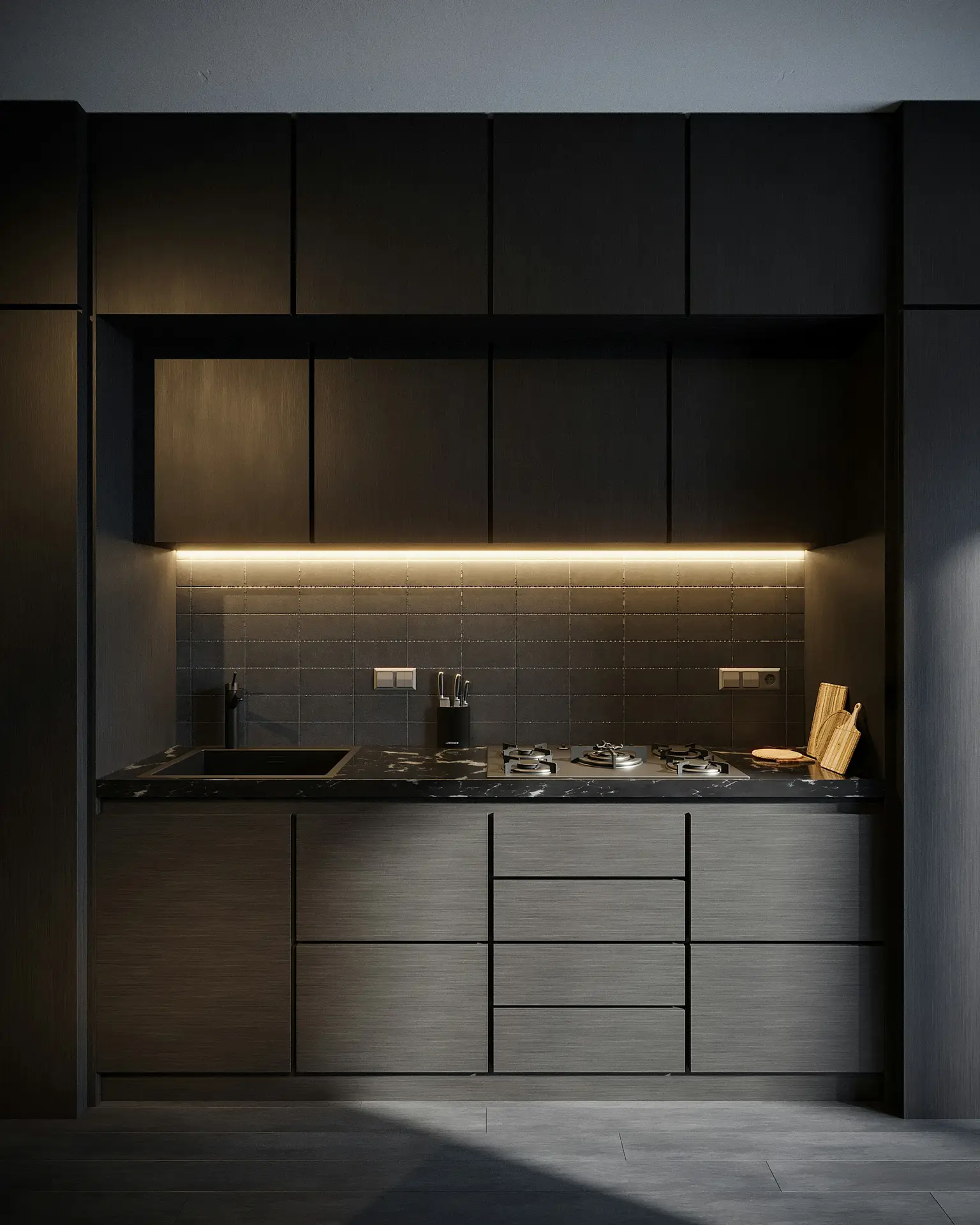
Under cabinet lights always catch my eye because they brighten the exact spot where I chop, cook or make coffee.
They double up as both practical task lighting and a cozy accent in the evening.
To keep them looking neat and effective, I think continuous LED strips with a diffuser work best, placed near the front edge so the counters are evenly lit.
2. Glass Pendant Lights

Glass pendant lights catch light in a really nice way. Like little orbs that brighten things up without feeling heavy or too intense.
They work with pretty much any kitchen setup. Hang them low over an island or line a few up for something more dramatic.
Clear glass if you want it airy, frosted if you want softer light. Put them on dimmers so you can go from bright task lighting to chill evening mood.
3. Flush Mount Ceiling Light

Like light that spreads evenly everywhere? Flush mount ceiling lights do exactly that.
They brighten every corner without taking up space.
They’re perfect for smaller kitchens where pendants would be too much.
Want it clean? Get one with a frosted diffuser, match the finish to your cabinet hardware, use dimmable bulbs so you can adjust it throughout the day.
4. Globe Pendant Lights
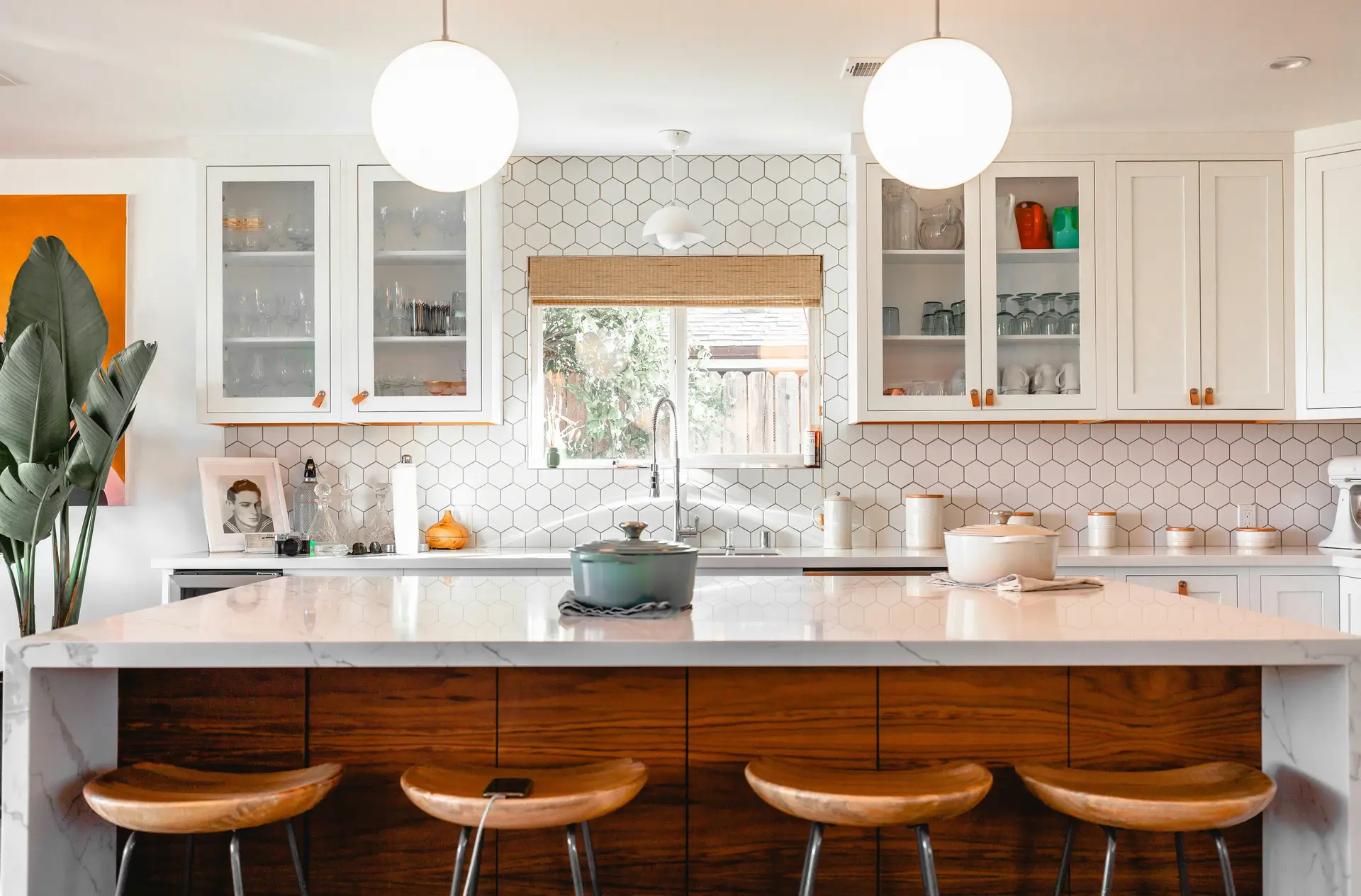
I just love how globe pendant lights can work in nearly any kitchen, hung in a row over an island for symmetry or as a single statement piece above a breakfast nook.
I suggest to choose clear globes for a modern edge, frosted ones for diffused light and always check the hanging height so they don’t block sight lines.
5. Hanging Lights Above Island

You want a light that creates a natural focal point? Hang lights above your kitchen island where everything happens: Cooking, eating, talking.
Style them however: Sleek pendants for modern, glass globes for airy, linear fixture for bold.
I recommend to hang them 75-90cm above the counter, space them evenly and put them on dimmers.
That way it’s bright when you’re working and soft when you’re done.
6. Woven Rattan Pendant Light
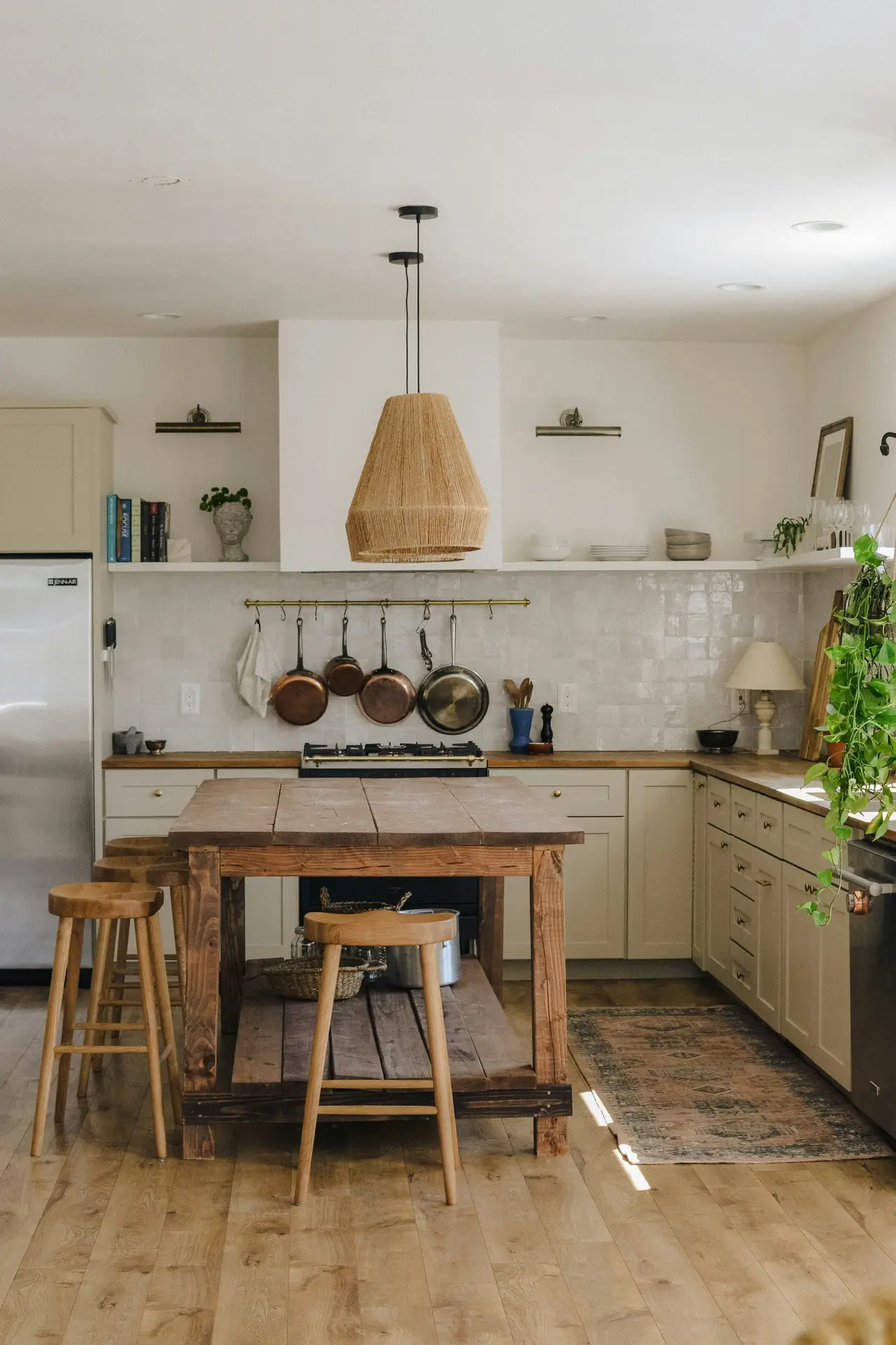
Rattan shades create this warm glow that spreads across the kitchen.
It adds texture and a natural feeling.
Try one above a dining nook or a few over the island.
Echo it with small touches like baskets, wooden stools and linen stuff.
This works in coastal kitchens, modern ones and farmhouse style which makes it pretty versatile.
7. Hanging Lights Above Floating Shelf
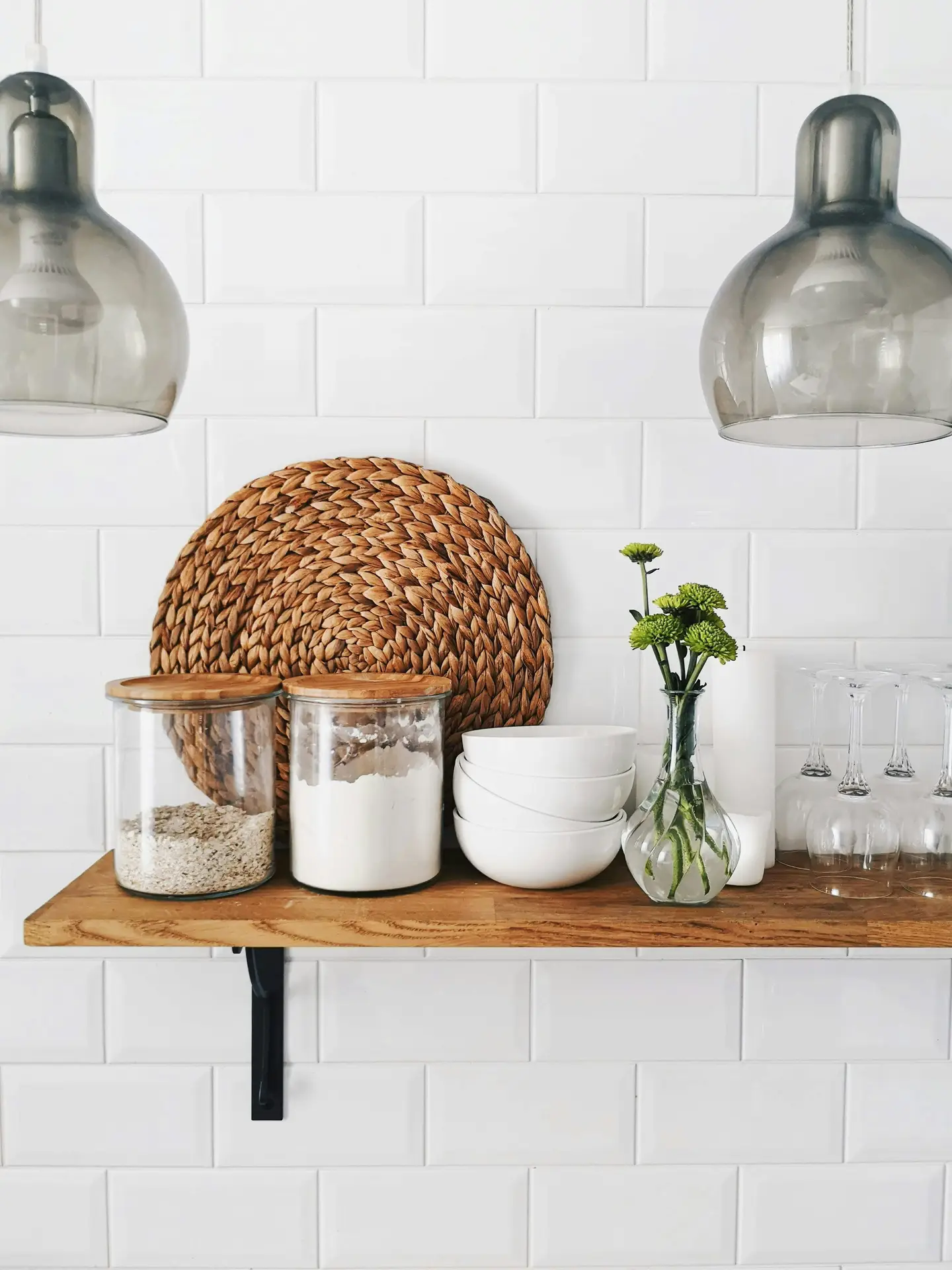
Picture a floating shelf softly illuminated from above, where the light pools over jars, greenery or a favorite ceramic piece.
Hanging lights work like a spotlight in this setup.
In my opinion, this detail turns simple storage into a styled display.
To make the look work, choose a compact pendant or mini-spot, keep the items on the shelf curated and repeat a texture, like wood or glass, so the look stays cohesive.
8. Recessed Ceiling Lights

Recessed ceiling lights are one of those things that don’t look like much, but they do the heavy lifting.
Even, ambient light everywhere without any fixtures hanging down or getting in the way.
I think of them as foundation lighting. They handle the basics, making sure you can actually see what you’re doing and then you can layer in the prettier stuff like pendants or under-cabinet lights for personality.
Spacing matters more than you’d think.
A rough rule is to put them about half your ceiling height apart. So if you’ve got a standard ceiling around 240cm, space them roughly 120cm apart.
And keep them back from your cabinets, maybe 40 to 60 centimeters, or you’ll end up working in your own shadow, which is incredibly annoying.
One more thing: Put these on a dimmer if you can. Being able to turn the brightness down at night makes a huge difference. Kitchen lighting at full blast when you’re trying to wind down feels harsh.
9. Geometric Pendant Lights
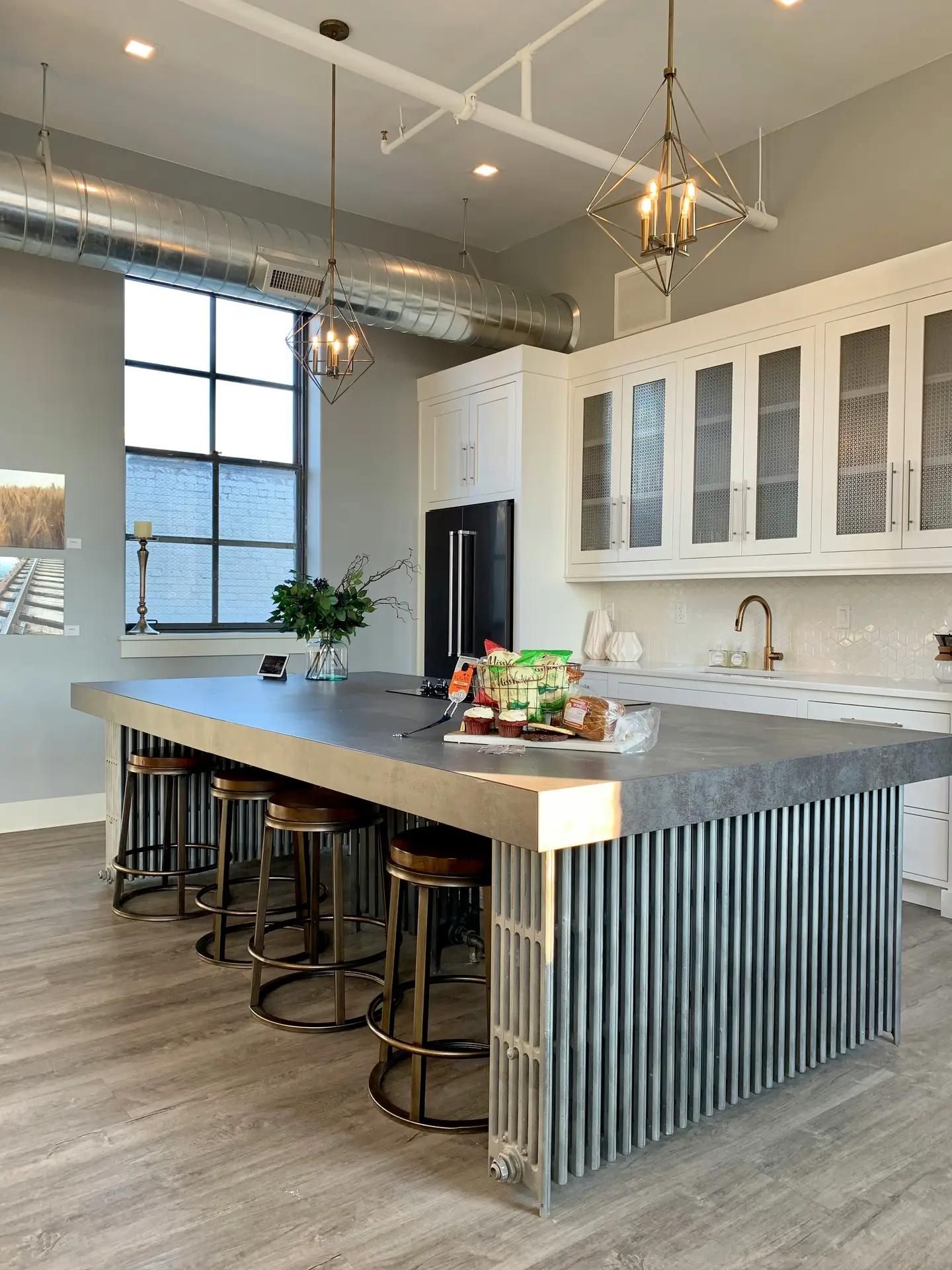
If you like geometric sculptures, this kitchen lighting idea is for you!
Geometric pendant lights don’t only cast striking patterns of light and shadow, they also add structure and visual interest to your kitchen.
My styling-tip is to choose finishes that echo your cabinet hardware and keep the shapes balanced with simpler surroundings.
10. Wall Sconce – Kitchen Lighting Ideas

Wall sconces in the kitchen, hear me out.
They’re not just for hallways.
A pair of them in the right spot, maybe flanking a window or lighting up a dark corner, adds this warm glow that overhead lights just don’t give you.
Personally, I think they’re a great way to frame open shelves or highlight a small breakfast nook without taking up precious kitchen counter space.
They make the kitchen feel less utilitarian, more like a room you actually want to be in.
The trick is matching the finish to hardware you already have: Your cabinet pulls, faucet, that kind of thing.
Otherwise they look random and tacked on.
And get bulbs you can dim. You need bright light when you’re cooking, but at night when you’re just grabbing water or cleaning up, full brightness feels way too intense.
11. LED Strip Lighting
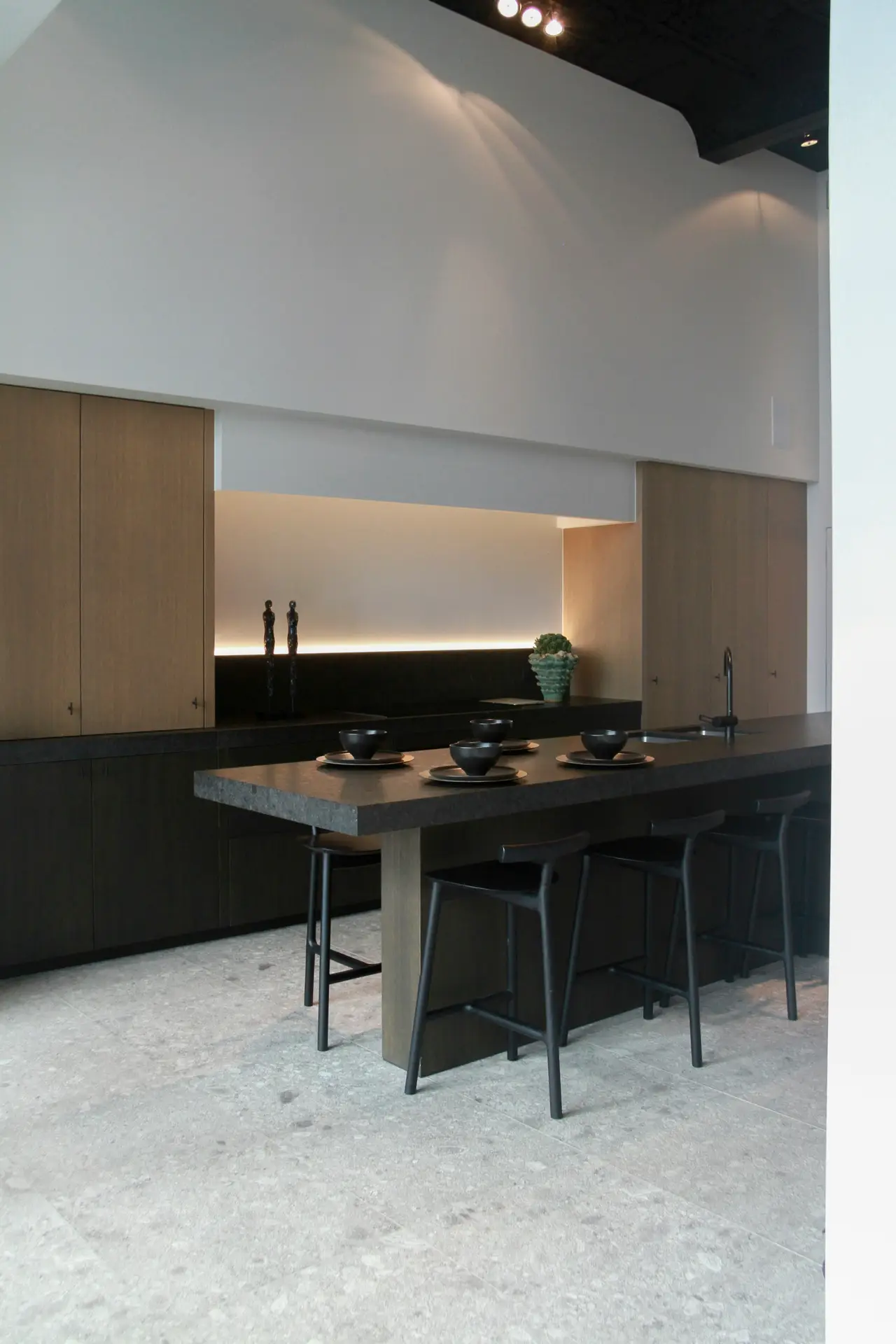
LED strips are one of those things I slept on for way too long. Turns out they’re actually useful, not just for that futuristic vibe people go for.
You can hide them under cabinets to light up your counters, run them along open shelves or even put them down at floor level for a really subtle glow. More options than you’d think.
If you want them to look intentional and not like you stuck Christmas lights under your cabinets, get continuous strips with a diffuser, that’s the cover that makes the light smooth instead of dotty.
Mount them toward the front edge of the cabinet or you’ll just be lighting up the backsplash instead of where you’re actually working.
And go with warm white. Cool white in a kitchen feels like a morgue.
What I like about them is they’re genuinely practical during the day when you need task lighting, but then at night you can dim them down and suddenly your kitchen feels cozy instead of clinical.
It’s a cheap upgrade that does more than you’d expect.
12. Oversized Light Bulbs
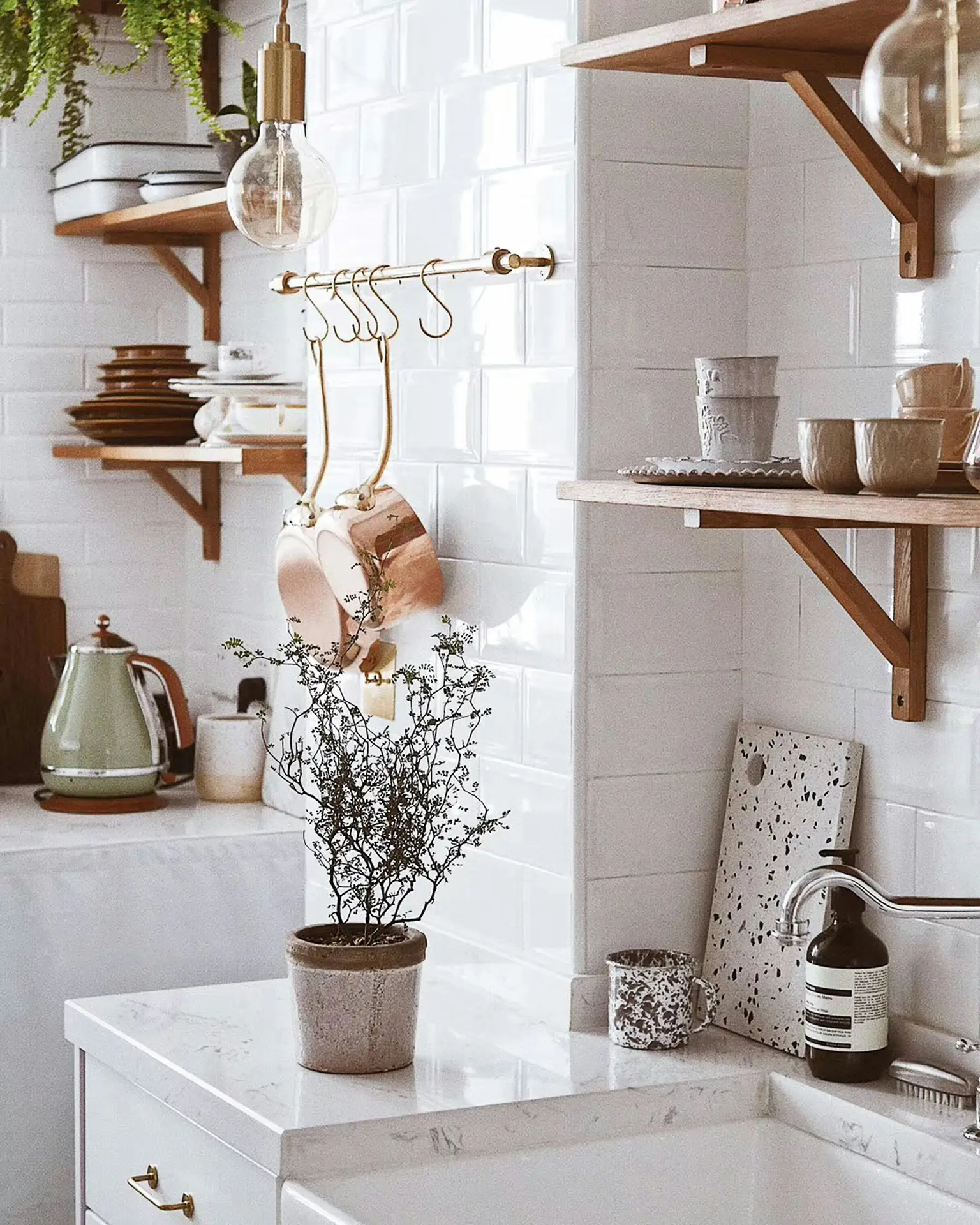
Oversized light bulbs bring a bold, graphic touch to a space, turning even a simple fixture into a statement piece.
They look especially great in modern kitchens as lighting concept when grouped above an island or paired with minimalist pendants.
My advice is to choose warm-toned bulbs, hang them at eye level and mix them with softer accent lights.
13. Industrial Pendant Lights

Industrial pendant lights add a raw, architectural edge, often combining metal shades, exposed bulbs or matte finishes for a striking look.
In my eyes, they’re perfect above an island or dining bar, where they can anchor the space.
It’s amazing how industrial pendant lights blend into a variety of styles, what makes them a great choice for most types of kitchens.
For the best effect, keep the finish consistent with your hardware, hang them low enough to define the area and use dimmers so they shift easily from bright task light to a softer evening glow.
14. Wall-Mounted Swing Arm Sconce

Swing arm sconces in the kitchen are more clever than they look.
You mount one next to your shelves or wherever you prep food and you can actually move the light around to point exactly where you need it.
What’s nice is they solve a problem and look good doing it.
You get focused light for chopping or reading a recipe, but it also just looks like a thoughtful design choice instead of purely functional.
A few things to get right: Match the finish to your cabinet handles and drawer pulls so it feels cohesive. Make sure the shade isn’t weirdly oversized or tiny for the wall, it should look proportional.
And check that the arm has room to swing without smacking into your things every time you adjust it. Sounds obvious, but I’ve seen people mount them too close to shelves and then wonder why they never use them.
15. Modern Metal Wall Sconces
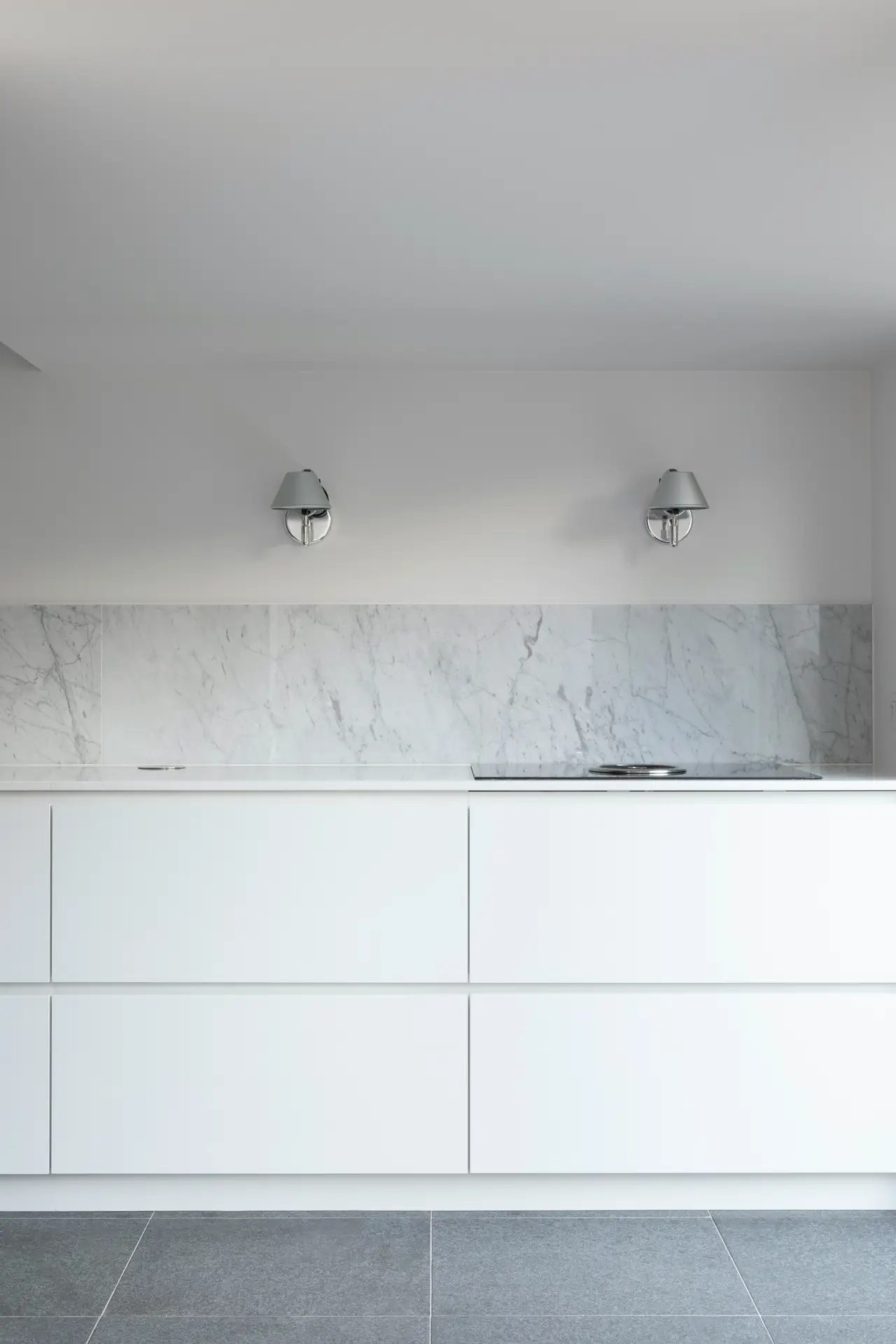
Sleek metal sconces can add just the right touch of polish to a wall or shelving area.
I suggest to use them in pairs to frame a feature, like a backsplash or display shelf, while still providing useful light.
It looks best when you repeat the same metal finish elsewhere in the room and use warm, dimmable bulbs so the light stays inviting instead of harsh.
16. Wooden Linear Pendant Light
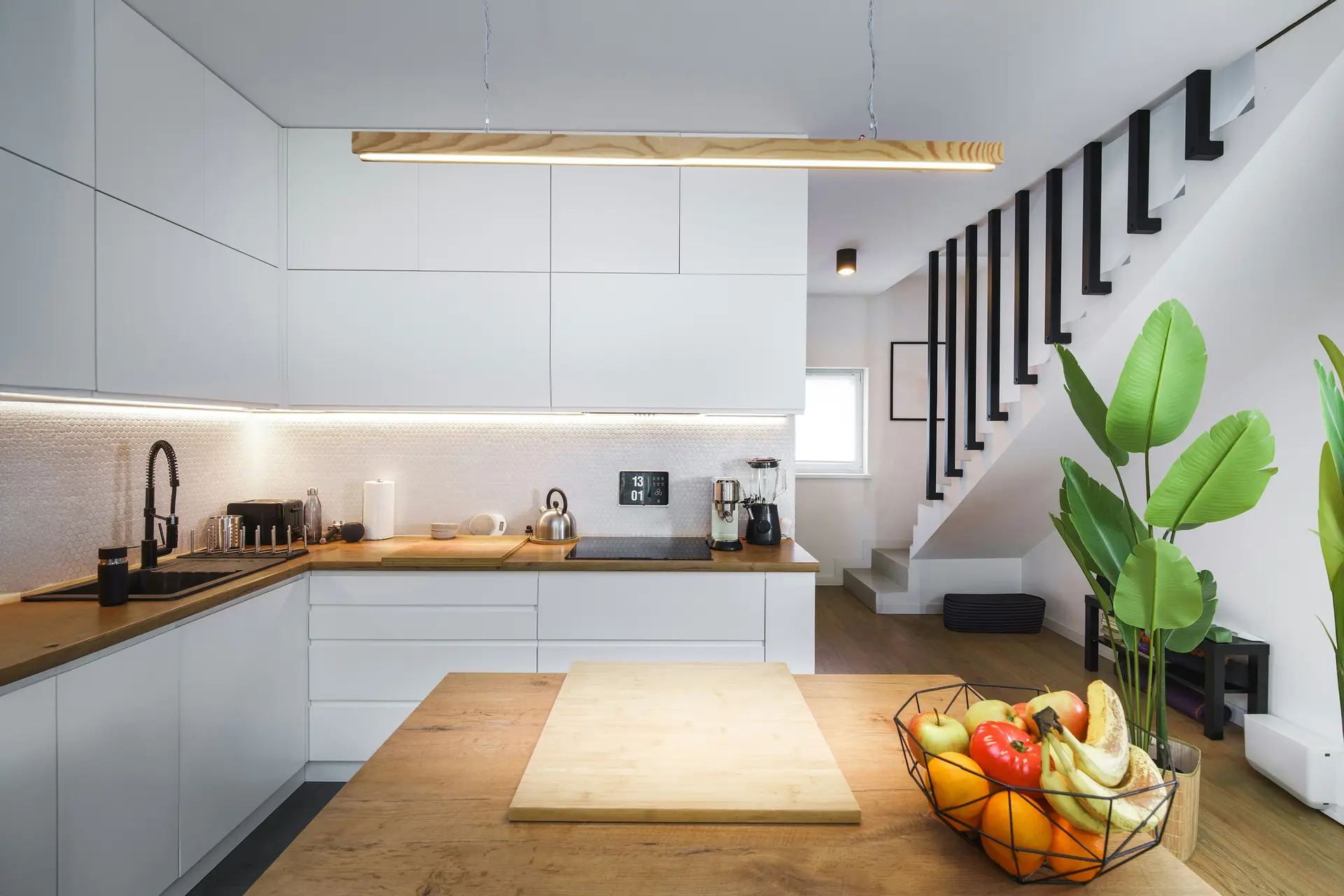
A wooden linear pendant brings a natural warm touch to the kitchen.
It stretches light evenly across an island or dining bar.
I think it’s a great way to balance modern lines with organic texture.
To get the most out of this look, hang it about 75-90cm above the countertop, pair it with neutral finishes and echo the wood tone in stools or shelving for a cohesive look.
17. Lights Under The Cooker Hood

The lights under your cooker hood, those little ones people barely think about, actually matter more than you’d realize.
They shine straight down onto the stove so you can actually see what you’re doing instead of cooking in your own shadow.
Go with LEDs if you can choose. They last forever and don’t get weirdly hot. Warm temperature, not the cold blue-white kind that makes everything look depressing.
And this is annoying but true: You need to wipe down the covers every so often or they get gross and the light gets all dim and murky.
What I didn’t expect is how useful they are at night. When you’re done cooking and you turn off the main lights, those hood lights give off just enough of a glow that the kitchen doesn’t feel completely dark. It’s kind of nice, actually.
18. Lighting Mix
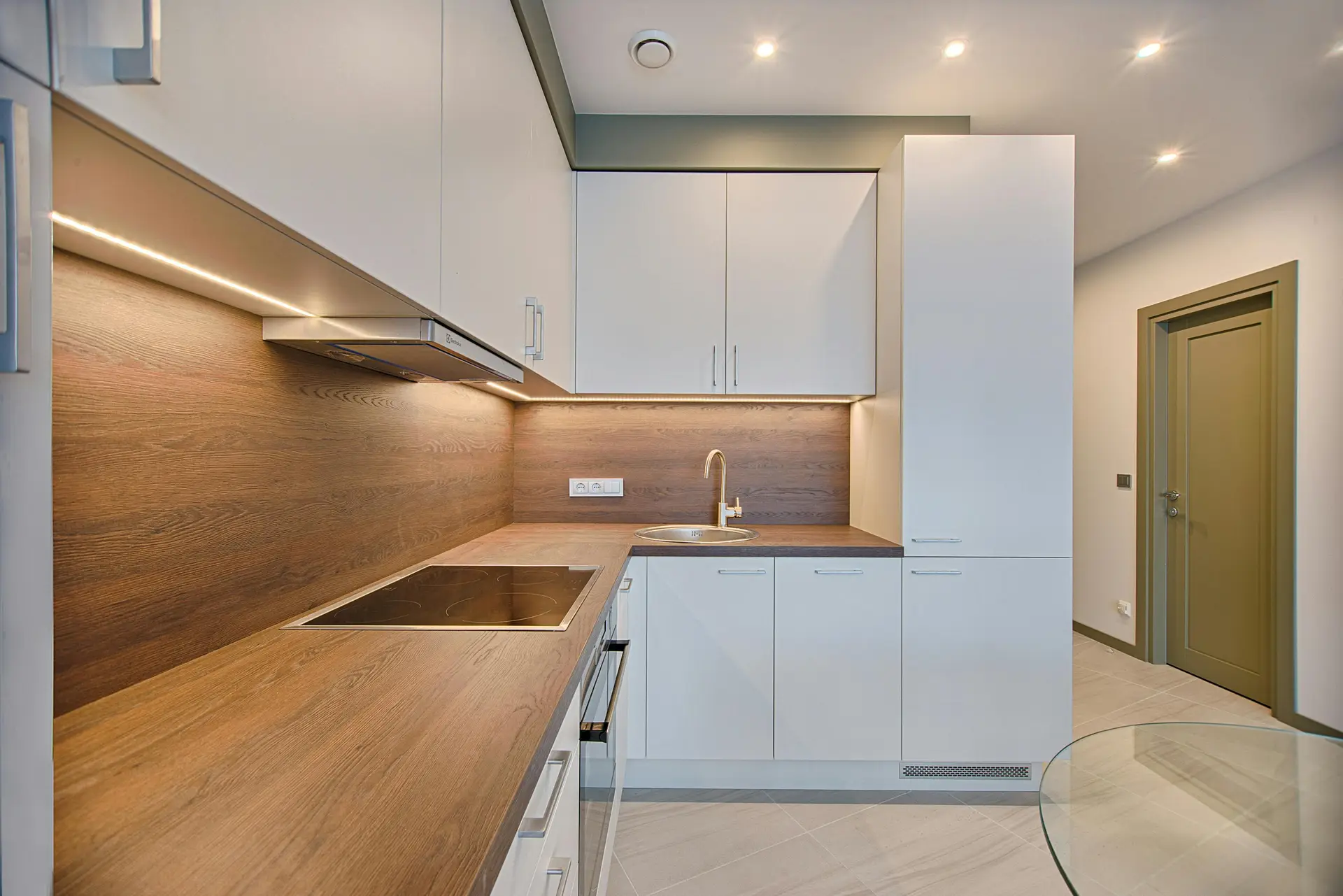
Kitchen lighting isn’t one-size-fits-all. You can’t just stick one type of light in there and call it done.
What actually works is having a few different sources doing different jobs.
Your ceiling lights keep the whole room lit so you’re not fumbling around in the dark.
Pendants over the island or table give you brighter, more focused light right where you need it.
And then stuff like under-cabinet strips or a sconce here and there? That’s what stops the kitchen from feeling like a cafeteria.
Here’s where people mess it up though, they mix light colors. Some bulbs are warm, some are cool and suddenly the whole room feels weird and you can’t figure out why.
Pick one temperature and stick with it everywhere. Warm white is usually the move.
Same thing with finishes. If your pendants are brass, don’t randomly throw in a chrome sconce. It looks accidental.
And please, dimmers on everything if you can swing it. The light you need at 7am when you’re making coffee is not the same light you want at 10pm when you’re wiping down counters.
Being able to adjust that is worth the extra fifty bucks or whatever it costs.
19. Black Dome Pendant Lights
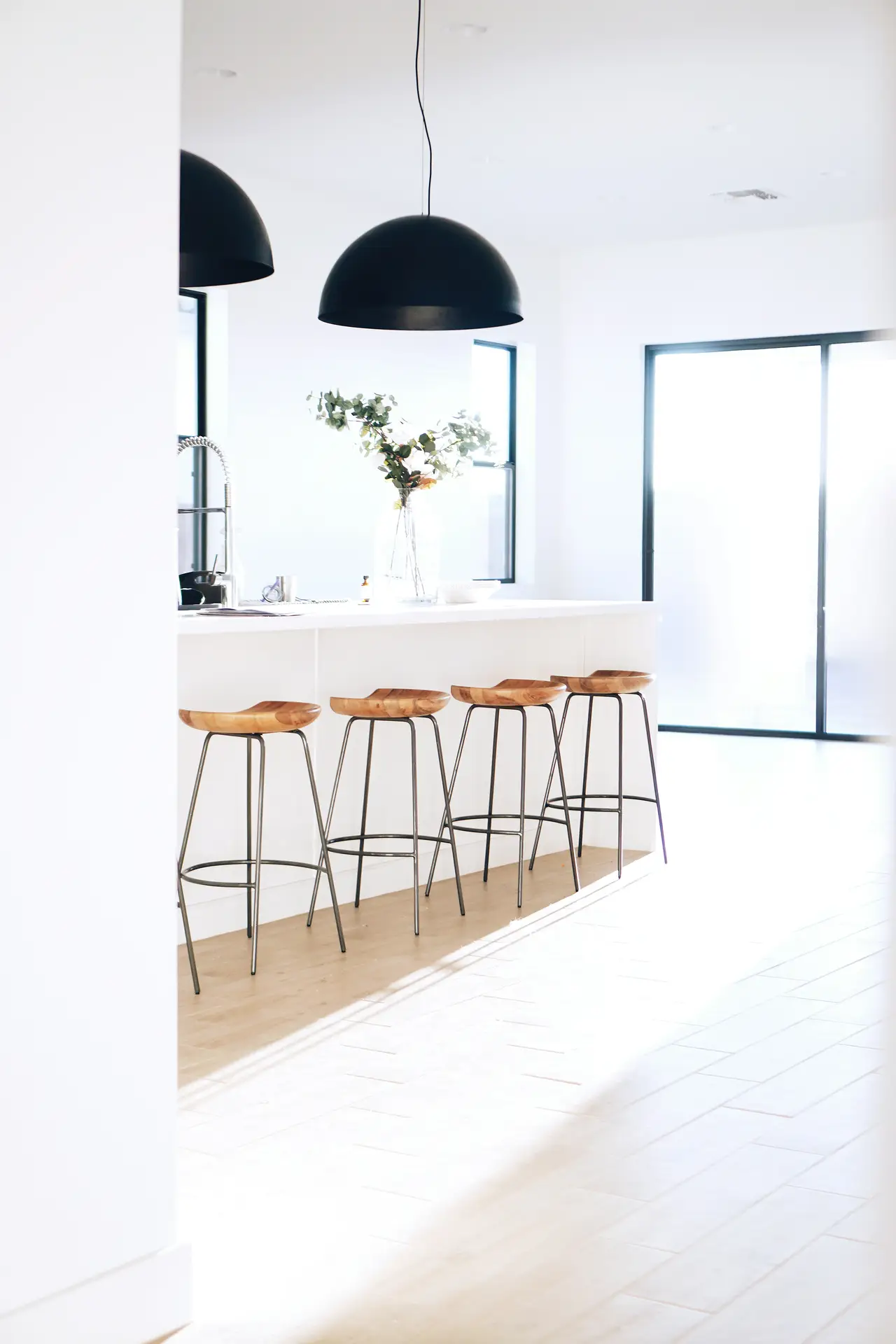
Black dome pendants bring a bold and timeless touch.
They are characterized by their simple shape and strong finish.
They work well over an island or dining table, where the curved shade directs light downward.
A practical tip: Pair them with lighter surfaces or natural wood, hang them evenly spaced and consider a matte finish for a softer, more versatile look.
20. Track Lighting – Kitchen Lighting Ideas
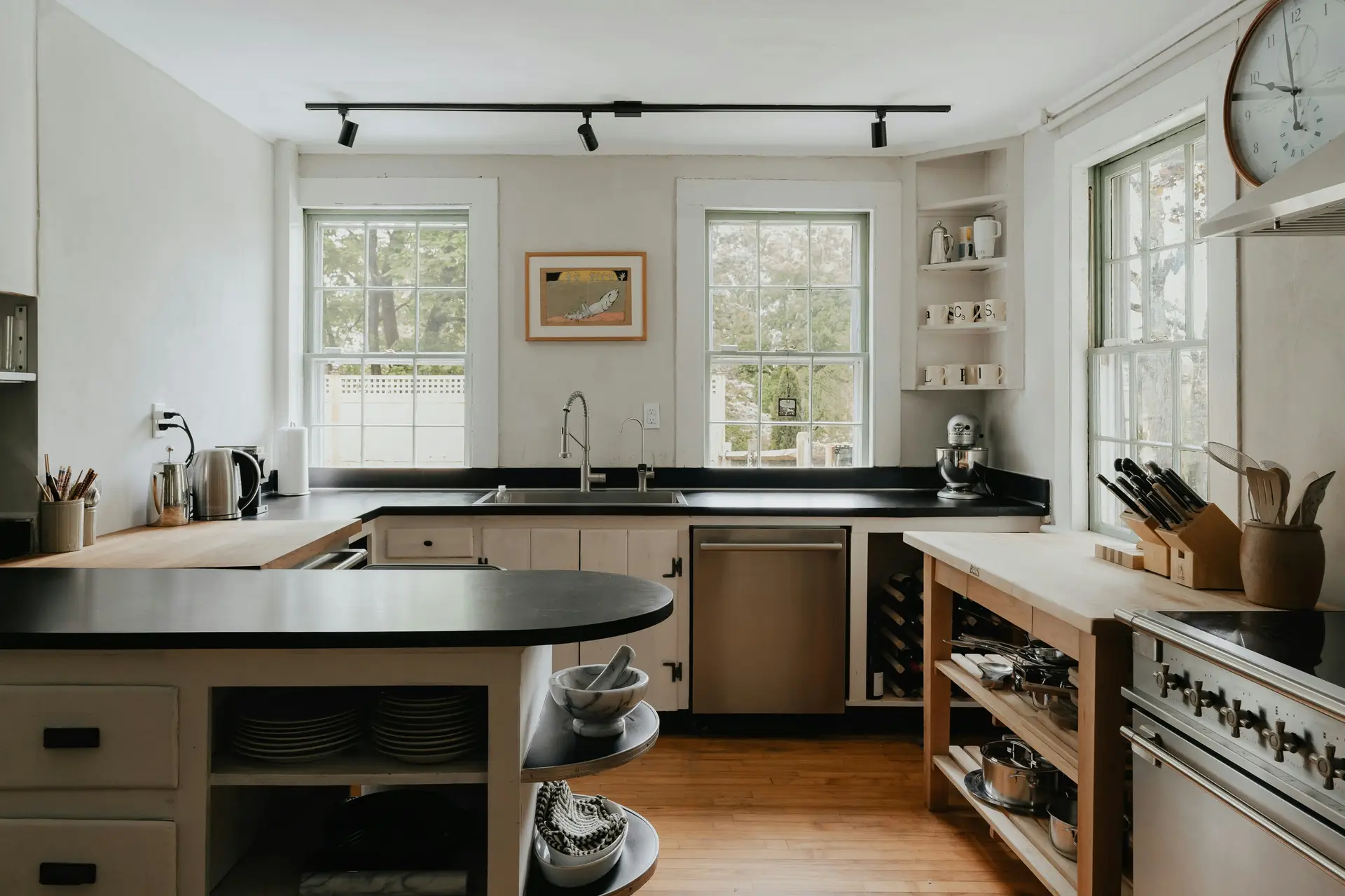
With adjustable heads lined up in a neat row, track systems make it easy to highlight different zones in the kitchen from prep areas to open shelving.
I think this kind of lighting is especially useful if you want flexibility, since you can redirect or swap bulbs as your layout or needs change.
For the best result, keep the track streamlined, angle the lights carefully to avoid glare and stick to a finish that doesn’t distract from the ceiling.
21. Brass Cone Pendant Lights
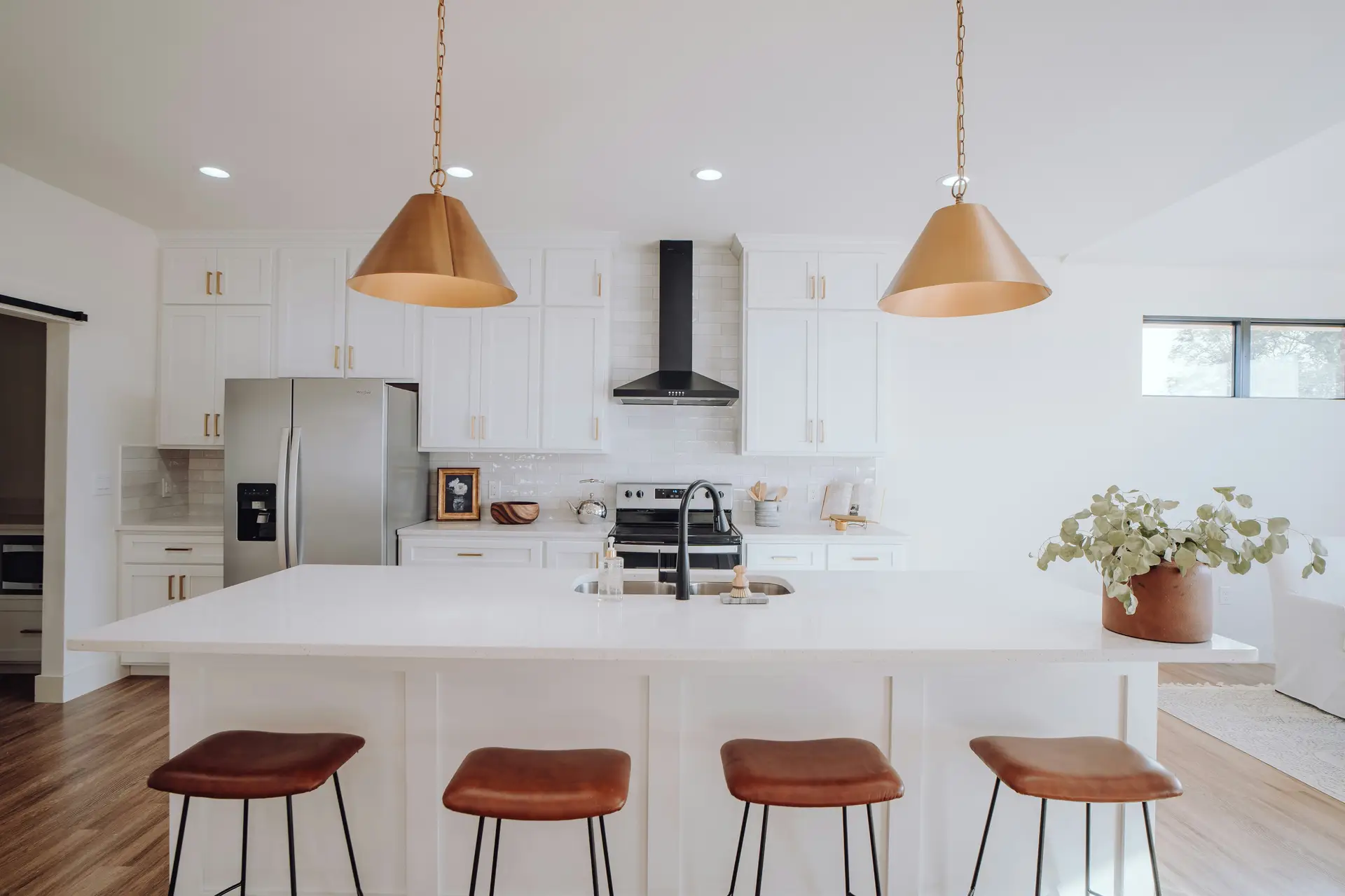
Brass cone-shaped pendant lights look elegant and put light exactly where you need it in the kitchen.
They work really well over islands or dining areas. The metallic finish catches the light and pairs nicely with wood, marble or dark cabinets.
Hang them in a row so there’s rhythm to it, keep them at the same height and repeat that brass elsewhere, cabinet handles, faucet, little touches like that. This ties it all together.
22. Metal Pendant Lights
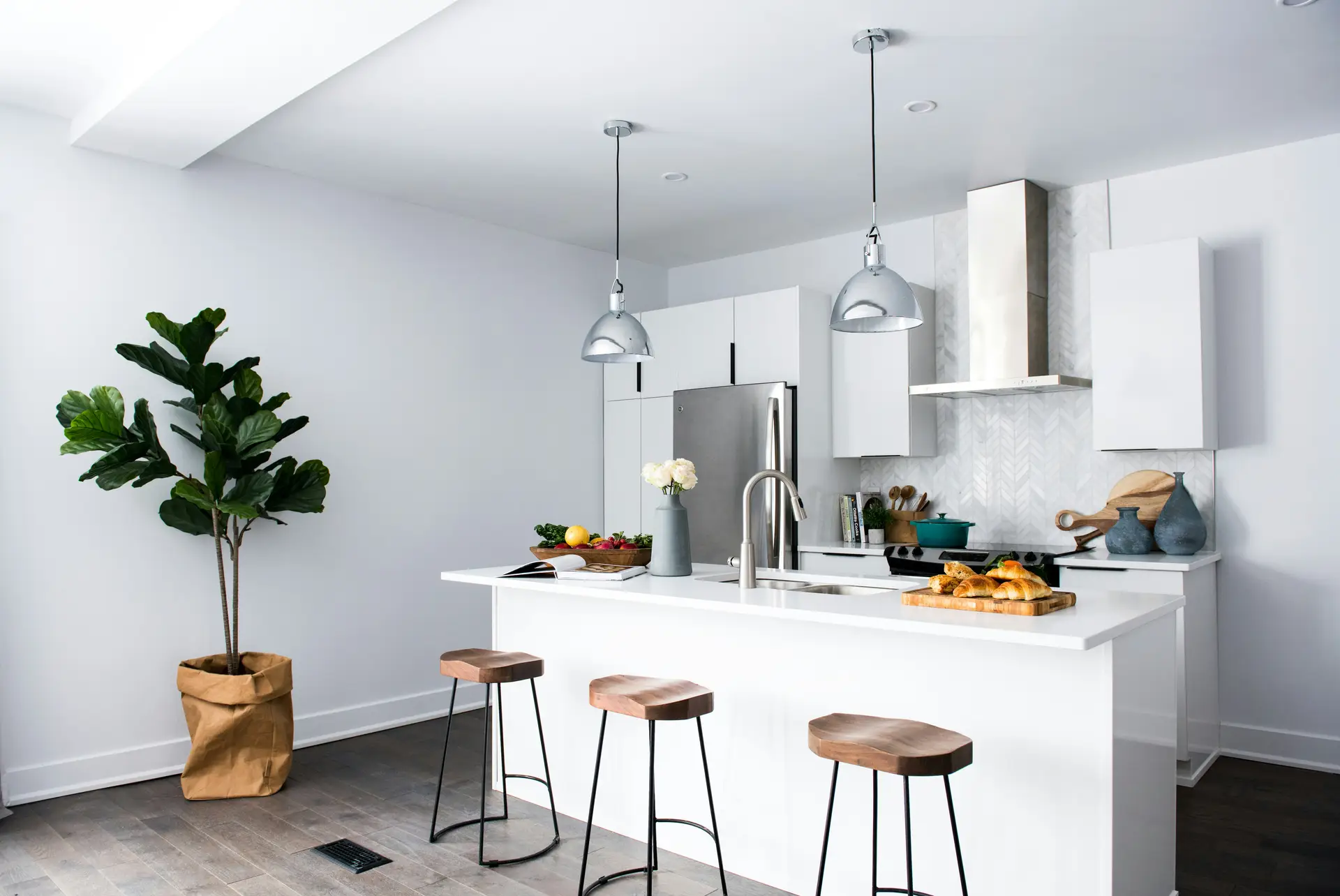
Metal pendants give your island or table a bit of shine without overdoing it.
They hold up well and don’t look cheap. That’s really what you want.
Style-wise they’re flexible. They work for modern, rustic, industrial or whatever direction you’re going.
I’d match the metal to your cabinet pulls and handles. This makes everything feel intentional.
Plus: Height matters. Hang them where they light things up but aren’t smacking you in the forehead.
And get two or three instead of one lonely pendant hanging there.
Common Mistakes & How To Fix Them Quickly
Even the best kitchen lighting plan can fall short if a few common mistakes slip in.
But: They’re easy to fix!
A quick checklist helps you to spot issues fast and fix them:
✅ Mixed 2700K, 3000K, 4000K → Unify to one CCT for consistency
✅ Under-cabinet spots instead of a line → Install continuous profiles to avoid “light islands”
✅ Pendants causing glare → Use an opal diffuser, hang a bit higher or add a dimmer
✅ Only ceiling light → Complement with under-cabinet and accent layers
✅ Flicker when dimming → Choose compatible dimmer/driver (check manufacturer lists)
Before You Flip The Switch: What To Remember
Good kitchen lighting is never just about brightness, it’s about creating a space that feels inviting and helps you in everyday life with functionality from morning coffee to late-night cooking.
I think it’s best to layer ambient, task and accent light, while keeping proportions, finishes and color temperature consistent.
With the right choices, your kitchen doesn’t just work better, it becomes a place where light highlights every detail and makes the room feel truly alive.
If you enjoyed these ideas, feel free to explore more inspiration and practical tips throughout my blog.
Did you enjoy this article?
If you’d like, treat me to a coffee ☕ Your support means the whole world to me!
